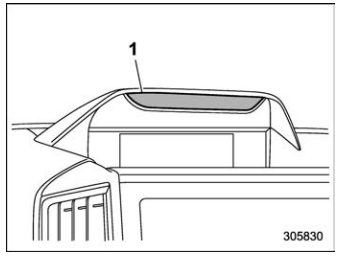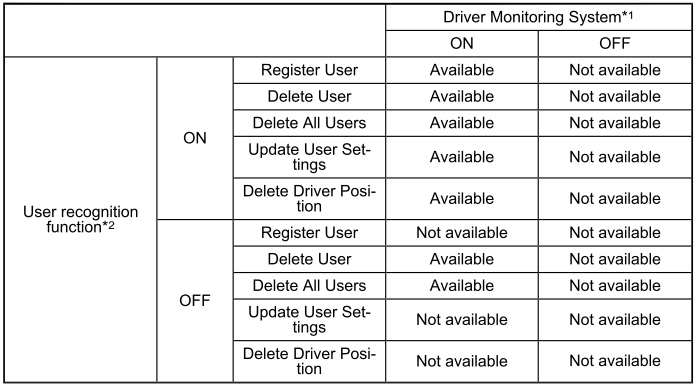Subaru Forester: Starting and operating / Driver Monitoring System (if equipped)
Driver Monitoring System is introduced as DriverFocus in some countries. The Driver Monitoring System monitors possible cases when the driver is not paying attention to the forward direction, and also recognizes individual users. This system warns the driver of inattentive/ drowsy driving, and can support safe and comfortable driving by automatically retrieving the following settings.
- Driver’s position
- Climate control setting
- Meter setting
- Multi-function display setting
When a user is registered, various settings are automatically retrieved when the user enters the vehicle.

Camera
CAUTION
- Always use the utmost care in
driving
- Overconfidence because you are driving a vehicle with the Driver Monitoring System could easily lead to a serious accident.
- This system cannot detect if the driver is feeling drowsy or is concentrating on safe driving.
- It cannot judge if the driver is awake or asleep, if their driving abilities have diminished, or if they are concentrating on safe driving.
- In some circumstances, the system may not be able to correctly detect the driver state.
NOTE
- The user recognition camera does not save images, audio, or video.
- The Driver Monitoring System may
not operate correctly when sunlight is
shining into the vehicle in the following
ways.
- Sunlight is shining directly (or through glass) onto the user recognition camera.
- There are shadows on the driver’s face caused by sunlight (or any light with a strong infrared component).
- There are large momentary fluctuations in the strength of the sunlight (or any light with a strong infrared component) shining on the face.
- Correct detection may not be possible when a device that includes an infrared light source (such as a commercially available driver monitoring system) is installed in the vehicle interior.
- The Driver Monitoring System may
not operate correctly at the following
times when the driver is wearing
glasses or sunglasses.
- The sunglasses do not allow the easy passage of infrared light.
- The surrounding scenery is reflected strongly in the lenses of the glasses or sunglasses.
- The eyes are hidden by the frame of the glasses and the user recognition camera cannot detect the eyes.
- The light from an infrared light source (LED) is reflected in the lenses of the glasses or sunglasses.
- The driver is wearing an eyepatch.
- The driver is wearing a hat set deeply over the eyes.
- Depending on the type of mask, correct detection of inattentive/drowsy driving may not be possible.
- Correct user recognition is not possible if the eyes, nose, or mouth is covered with a mask, muffler, sunglasses, or other item.
- The Driver Monitoring System may not operate correctly when the eyebrows, eyes, nose, or mouth is hidden due to item that is between the face and the system.
- If a thick cover is attached to the steering wheel, then depending on the position set for the tilt/telescopic steering wheel, the cover may block the system’s view of the face, and the system and the Driver Monitoring System may not operate correctly.
- Do not attach any stickers to the user recognition camera or the infrared light source (LED). If the user recognition camera or infrared light source (LED) is covered by an obstruction, it will not be possible to correctly monitor the driver.
- If an accessory is hung from the inside mirror, correct detection may not be possible.
- Do not touch the user recognition camera or the infrared light source (LED) directly with your fingers. If there is dirt or a fingerprint on these parts, it will not be possible to correctly monitor the driver. If there is dirt or a fingerprint on these parts, either wipe them with a soft dry cloth, or wipe gently with a damp cloth after first firmly wringing the water out.
- If the surface of the user recognition camera or the infrared light source (LED) becomes scratched, correct detection may not be possible. Be careful that hard objects do not contact these parts.
- If there is condensation on the user recognition camera or the infrared light source (LED), correct detection may not be possible. If there is condensation on these parts, wipe it away with a soft dry cloth.
- When registering a user for user recognition, avoid closing your eyes as much as possible.
- If the user recognition success rate is low, it is possible that the user is not correctly registered. Delete the registered data and perform registration again.
- If a user frequently drives both with glasses and contact lenses, it is recommended that registration be performed both when wearing glasses and when wearing contact lenses.
- User recognition starts immediately after entering the vehicle, however if the user looks downward or at the driver side mirror for a long time, the user may not be recognized.
- When one person among twins or another pair of persons with similar facial features is registered, the other person may be incorrectly recognized as the registered user when entering the vehicle.
- If the person in the passenger’s seat leans into the driver’s seat, or in other cases when there are two or more faces near the driver’s seat, the system may not operate correctly.
- There are cases when the system concludes that the user’s eyes are closed when the user is looking downward during driving, such as when checking instruments or the navigation screen. In such cases, the drowsy driving warning buzzer may sound or the system may otherwise not operate correctly.
- If the eyes are narrowed when laughing or when there is a dazzling outside light, the system may judge that the eyes are closed and the drowsy driving warning buzzer may sound or the system may otherwise not operate correctly.
- The drowsy driving or asleep warning states are recognized from the length of time and percentage of time that the eyes are closed. The drowsy driving warning buzzer will not sound simply when the driver feels sleepy or yawns.
- Even when the driver does not feel sleepy, if his or her eyes are closed or if he or she blinks frequently, the drowsy driving warning buzzer may sound.
- The inattentive driving warning buzzer may sound if the driver leans forward or puts his or her head out of the window while driving.
- The inattentive driving warning buzzer will not sound when the vehicle is stopped or travelling at slow speed even if the driver is not looking ahead.
- The Driver Monitoring System collects and stores data regarding drivers’ facial features. Facial recognition data is stored locally and does not leave the vehicle. It is not transmitted to or stored by SUBARU or anyone else. The Driver Monitoring System may be disabled and any stored driver data may be deleted by following the instructions below. If the Driver Monitoring System is disabled, it will be unable to provide any of its safety or convenience functions.
The functions which are available vary depending on the Driver Monitoring System setting and the user recognition function setting.
Available functions

Available function items

*1: The system can be turned ON/OFF with the Driver Monitoring System OFF switch. Refer to “Driver Monitoring System OFF switch”.
*2: The function can be turned ON/OFF in the multi-function display customization settings. Refer to “User Recognition settings”.
The functions which are available vary depending on whether or not the user is registered.
Available functions

- User recognition function
- Inattentive/drowsy driving warning
- Driver Monitoring System indicator/warning
- Using the Driver Monitoring System . User recognition
- When a user is not recognized
- Registering and deleting a user
- Registering and deleting driver position personalization
- Driver Monitoring System ON/OFF settings
- Certification for Driver Monitoring System
 User recognition function
User recognition function
WARNING
Perform registration, retrieving, or
delete of the seat position and outside
mirror angle before beginning
driving. There is the risk of an
accident if registration, retrieving,
or delete is performed while driving...
Other information:
Subaru Forester 2019-2025 Owners Manual: Disabling functions
By operating the access key fob If you have registered a PIN code for PIN Code Access, you can disable the keyless access function by operating the access key fob. For details about registering a PIN code, refer to “Unlock using PIN Code Access”...
Subaru Forester 2019-2025 Owners Manual: Washing
CAUTION When washing the vehicle, the brakes may get wet. As a result, the brake stopping distance will be longer. To dry the brakes, drive the vehicle at a safe speed while lightly depressing the brake pedal to heat up the brakes. Do not wash the engine compartment and area adjacent to it...
Categories
- Manuals Home
- Subaru Forester Owners Manual
- Subaru Forester Service Manual
- Steering Responsive Headlight (SRH)
- Power steering warning light
- Reverse Automatic Braking (RAB) system ON/OFF setting
- New on site
- Most important about car
Driving information display
NOTE
You can set the units for both the multifunction display (black and white) and the combination meter at the same time. For details about setting the language and units, refer to “Type A combination meter” or “Menu screens”.

